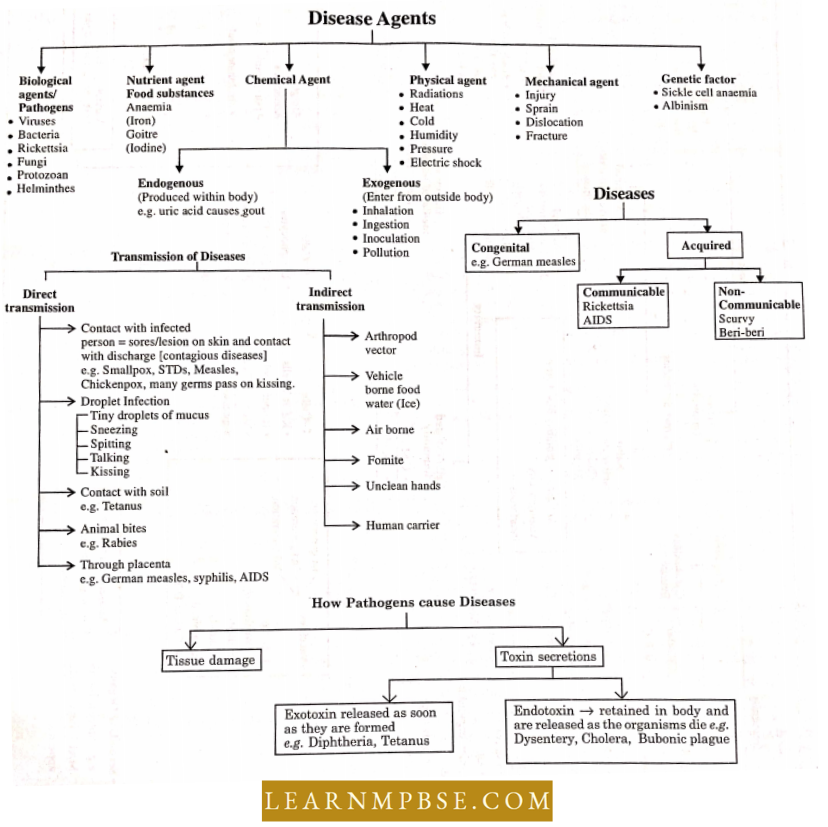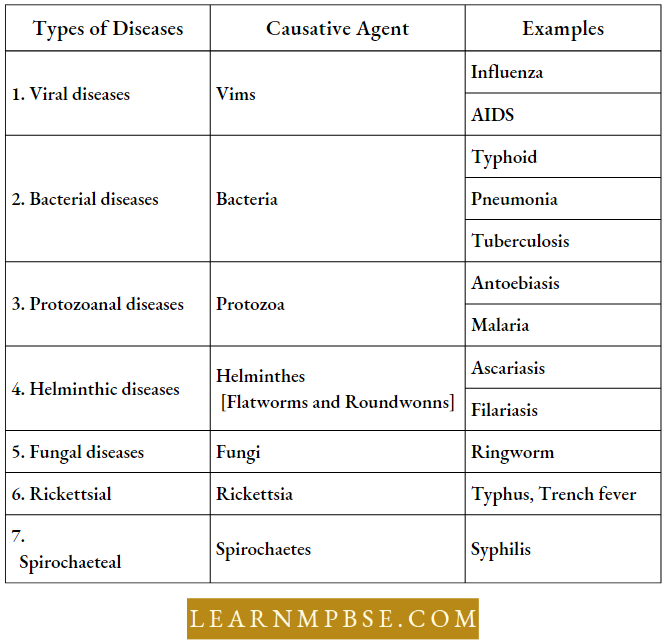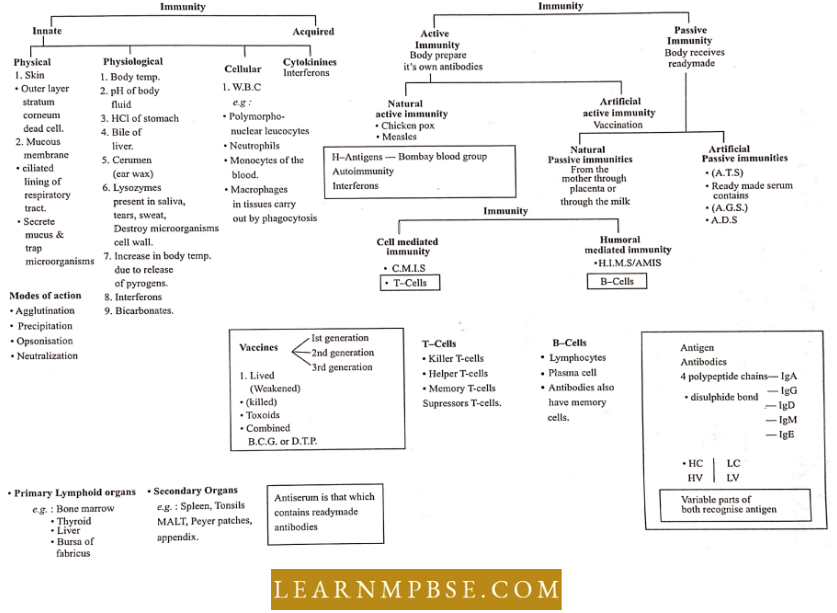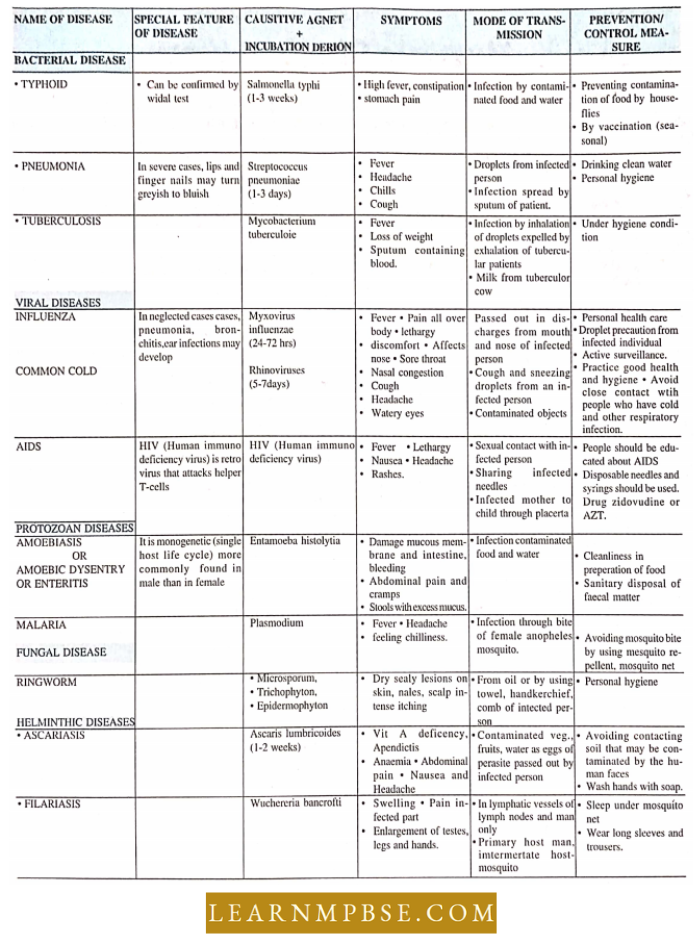Human Health And Common Human Diseases For NEET
Disease. It is defined as a condition of the body or a part of it in which functions are disturbed. The word disease means lack of ease and comfort.
Health. It is a state of complete physical, mental and social well-being. Health is also linked with social environment and cultural background.
Koch’s Postulate. Robert Koch (1876) studied diseases and pathogens of anthrax caused by Bacillus anthracite, later on, tuberculosis caused by Mycobacterium tuberculosis (1882) and cholera caused due to infection of Virbrio cholera (1883). He proposed the following four criteria for establishing an agent of infectious diseases.
The organism must be regularly found in the body of animals that have the disease.
- It must be possible to isolate the organism and grow it in pure culture on artificial media.
- A healthy animal must contract the disease and show its characteristic symptoms when it is inoculated with the culture of the organism.
- It must be possible to recover the same organism from the body of an inoculated animal.
Human Health And Diseases Notes For Neet
Kinds Of Diseases
Read and Learn More NEET Biology Notes
- Congenital Diseases. (Inborn diseases). Diseases contracted before birth due to defective heredity (chromosomal abnormalities and gene mutations), physiological disturbance or transplacental transmission for example, Haemophilia, Down’s syndrome, colour blindness, hare lip, and transplacental syphilis.
- Acquired Diseases. Diseases contracted after birth due to infection, defective diet, hypersensitivity, injury, addition, degeneration, depression, etc.
- Infectious Diseases. They are diseases due to pathogens that can be transferred from one individual to another for example, tetanus, measles, flu, malaria, typhoid, cholera, and tuberculosis.
- Deficiency Diseases. Diseases caused by absence or deficiency of an essential element, for example, anaemia, goitre.
- Degenerative Diseases. Diseases caused by ageing, result in malfunctioning or decreased efficiency.
Human Health And Common Human Diseases For NEET Disease Agents
Any substance which causes a disease by its excess deficiency or absence is called a disease agent.
Types of Disease Agents. Disease agents are of the following types:
- Biological Agents. These are also called pathogens (Gr. path means disease; genes means producing). These are those micro-organisms which when successfully infect the human body, multiply and produce toxins in the incubation period which interfere with the normal functioning of the body and cause a disease.
- These include viruses (mumps, chicken pox, smallpox),
- Mycoplasma, (for example bronchitis, acute leukaemia),
- Chlamydia (for example. trachoma)
- Bacteria (for example, cholera, tetanus),
- Fungi (ringworm, thrush, moniliasis, pulmonary aspergillosis),
- Protozoa (for example, giardiasis, sleeping sickness),
- Helminths (for example, filariasis, ascariasis, taeniasis), and
- Other organisms (for example, scabies).
- These include viruses (mumps, chicken pox, smallpox),
- Chemical Agents. Some chemical compounds are also causative agents of certain diseases. These are of two types on the basis of their source.
- Endogenous Chemical Agents. These are formed inside the body. These include urea, uric acid, hormones, enzymes etc.
- Exogenous Chemical Agents. These enter the human body from outside by ingestion, inhalation or inoculation. These include pollutants like gases, dust, metals etc. and allergens like spores, pollens etc.
- Nutritive Agents. These include minerals, carbohydrates, proteins, fats, vitamins and water.
- Physical Agents. These include heat (stroke), cold (frostbite), humidity, pressure, radiation, electricity, sound (impaired hearing) etc.
- Mechanical Agent. These include injuries, fractures, sprains, dislocations etc.
- Genetic Agents. Some diseases are caused by genetic causes and include haemophilia, sickle cell anaemia, etc.
- Degeneration. Due to old age.
- Social Agents. These may cause mental disorders.
- Unknown Reasons. The agents for certain diseases like peptic ulcers, hypertension and coronary heart diseases are yet to be identified.
Human Health And Common Human Diseases For NEET Modes Of Transmission
Communicable diseases are those diseases which can be transmitted from the reservoir of infection or an infected person to healthy but susceptible persons.
There are two modes of transmission:
1. Immediate Transmission Or Direct Transmission:
The pathogens are transmitted straight from an infected individual to a healthy individual without an intermediary agent. It manifests in the following manners:
- Through direct contact with an infected individual: Contagious diseases such as chickenpox, smallpox, athlete’s foot, measles, leprosy, ringworm, gonorrhoea, and syphilis are transmitted through direct contact between an infected individual and a healthy individual. Entamoeba gingivalis, the oral amoeba, is transferred through direct mouth-to-mouth contact, such as kissing.
- Droplet Transmission: Diseases such as diphtheria, influenza, the common cold, measles, TB, pneumonia, mumps, and whooping cough are transmitted through droplet infection, which involves pathogens contained in minute mucus droplets expelled during sneezing, coughing, spitting, or conversing with infected individuals.
- Animal Bites: Rabies viruses are transmitted to humans by the bites of rabid animals such as dogs, monkeys, and cats.
- Transplacental Transmission: The viruses responsible for German measles and the bacteria causing syphilis can be transferred from maternal blood to fetal blood via the placenta.
2. Indirect Transmission:
When infections are transmitted from the infection reservoir to a healthy individual via intermediary agents.
It manifests in the following manners:
- Vector-borne: Vector-borne diseases include, for instance, the tsetse fly (African sleeping sickness) and sandflies (kala-azar and oriental sores). Female Anopheles mosquito (malaria), rat flea (bubonic plague), Aedes mosquito (yellow fever), Culex mosquito (filariasis), and housefly (typhoid, cholera, dysentery, etc.)
- Pediculus humanus capitis (typhus) – Vehicle-borne: Pathogens responsible for cholera, dysentery, and typhoid are disseminated by vectors such as food and water. AIDS is transmitted through the blood of infected individuals.
- Airborne: Pathogens are disseminated through wind currents, aerosol sprays, and dust, as exemplified by epidemic typhus.
- Formite Borne: Pathogens are disseminated by contaminated items such as handkerchiefs, towels, dinnerware, toys, soap, cutlery, and surgical tools.
- Imperfect Hands: The pathogens responsible for disorders such as Ascariasis (Ascaris lumbricoides) and Enterobiasis (Enterobius vermicularis) are transmitted by contaminated hands; therefore, thorough handwashing is essential before to meals.
Human Health And Common Human Diseases For NEET Defence Mechanism Of Body
External Defence/ First, Line Of Defence/Physical And Chemical Barrier. It consists of physical barriers of skin, membranes, friendly microorganisms and chemical barriers.
- Skin. Keratinised dead outer epidermal cells do not allow entry to pathogens. Oil and sweat are inhibitory to the growth of most pathogens.
- Nostril Hair. They Filter out dust and microorganisms from inhaled air.
- External Friendly Microorganisms/Friendly Bacteria. Many friendly bacteria live on the skin and secrete chemicals harmful to pathogens.
- Mucous Membranes. They line digestive, respiratory and urinogenital tracts so as to prevent the entry of germs into body parts.
- Mucus And Cilia. The mucous membrane of the nasal tract possesses cilia for pushing back dust and germs. It also secretes mucus for trapping and killing them.
- Internal Friendly Microorganisms. They occur in the intestine and vagina.
- Chemical Barriers
- Sweat, oil and secretions of extremely friendly bacteria are acidic to prevent the growth of many pathogens.
- Lysozyme or bacteriolytic enzyme is present in sweat, tears, saliva and mucus.
- Hl of the gastric juice has germicidal properties.
- Bile does not allow the growth of microorganisms.
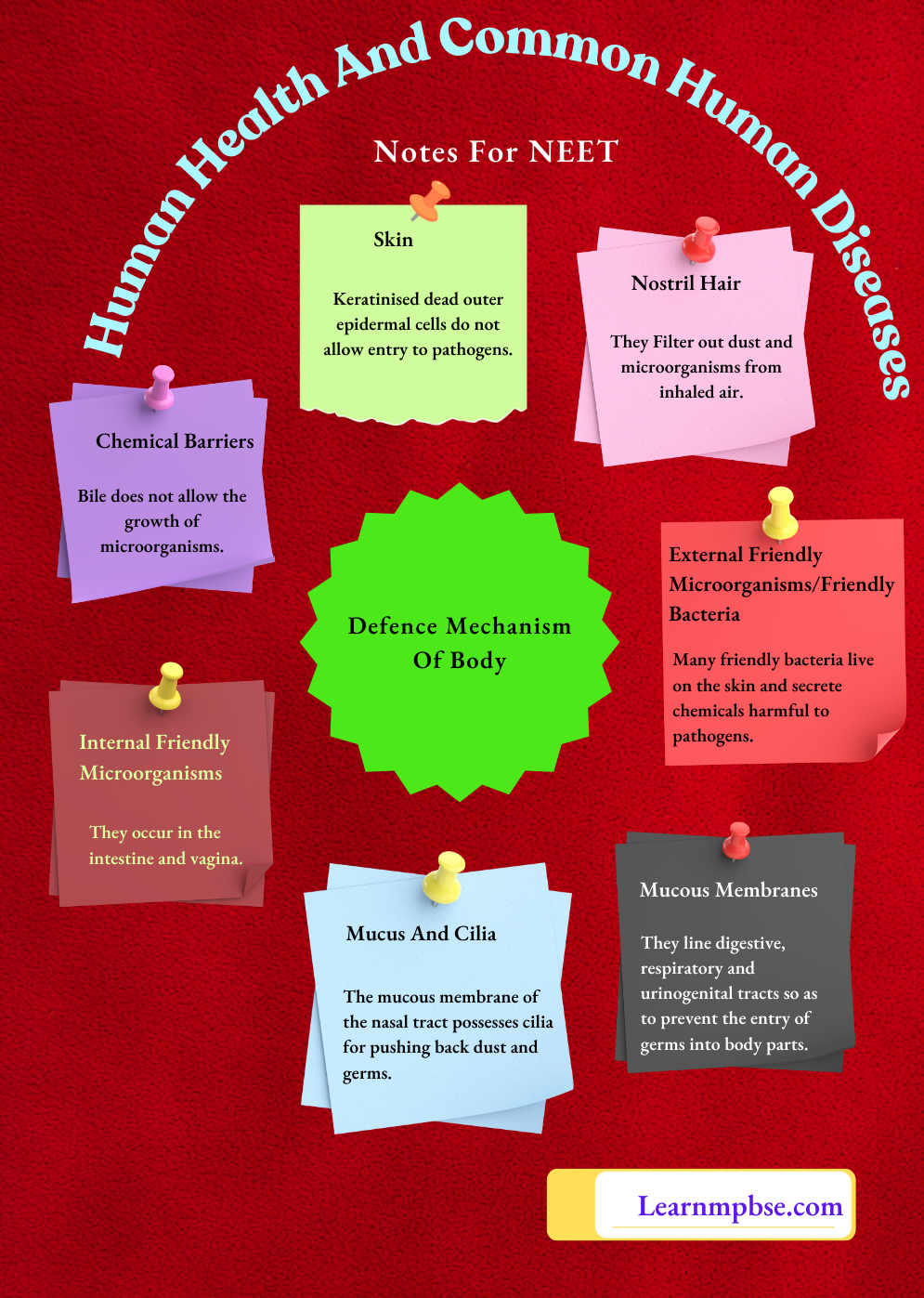
Non-Specific Internal Defence/Second Line Of Defence: A pathogen having entered body tissues/fluid is confronted with the second line of defence consisting of phagocytosis and inflammatory response.
- Phagocytosis. Phagocytes present in the blood come out of the capillaries through diapedesis. Phagocytes of blood and macrophages present in tissues attack germs and engulf them. Pus may collect. Pus is a thick liquid formed in the region of the wound and is composed of tissue fluid, damaged body cells, dead phagocytes, some leucocytes and microorganisms.
- Inflammatory Response. It is the reaction of living tissues to injury, irritation or infection which is characterised by pain, swelling, redness and heat. Inflammatory’ response can be localised (area of injury or infection) or systemic (whole body). It is caused by the release of an amine called histamine (C5H9N3) from body tissues and lymphocytes.
- Histamine dilates blood capillaries, makes them more permeable, lowers blood pressure, and allows greater leakage of phagocytes and plasma so that tissue fluid accumulates (histamine also stimulates gastric secretions and uterine contractions).
- Toxins released by pathogens, and endogens pyrogens (Substances capable of producing fever/pyrexia) produced by leucocytes raise body temperature to stimulate phagocytes and inhibit microorganisms.
- Pyrogens reset the thermoregulatory centres of the hypothalamus. However, body temperature may rise too high when it is brought down by the administration of antipyretic drugs (for example, paracetamol, and aspirin) and cold packs. Phagocytes attack vigorously when body temperature is high.
Specific Internal Defence Immune System/Third Line of Defence:
A constituent of a pathogen behaves as an antigen. Antigen (antibody generating) is any foreign substance like protein or polysaccharide present on the external coating of the pathogen, the toxin of the pathogen, white of egg, feathers, a constituent of a vegetable, fruit, meat, drug, chemical, tissue or organ transplant which induces the immune system to produce antibodies.
Human Health And Diseases Notes For Neet
Antibodies. Chemical substances are produced for the destruction of disease-producing external factors. Antibodies are made of complex proteins called immunoglobulins (Ig). They are of 5 types (IgM, IgG, IgA, IgD and IgE). Some important antibodies are tetanus antitoxin, agglutinins, bacteriolysis, oposonins etc.
Types Of Antibodies
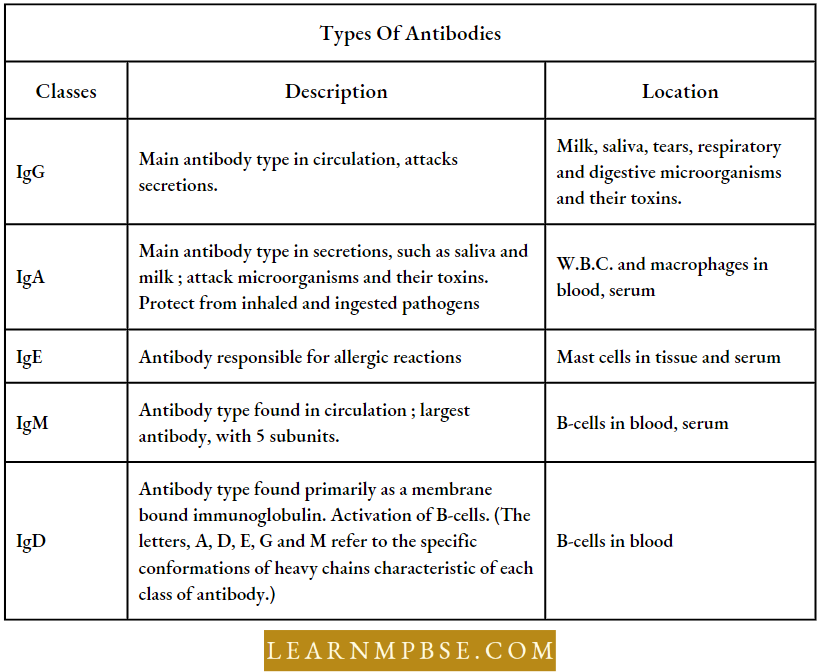
Structure Of Antibody And Its Specificity: An antibody is a globular protein consisting of four polypeptide chains; two identical heavy chains, with more than 400 amino acids each, and two Identical light chains, with about 200 ammo acids each.
Along half the molecule, carbohydrate groups are attached and the two heavy chains are held closely together by a series of disulphide bonds. Along the other half, the chains are aligned in two pairs, with one heavy and one light chain in each pair. The entire molecule is shaped like a Y. Each antibody molecule has two functions:
- An effector function or type of action taken to eliminate the antigen, and
- A specific antigen-binding function.
There are five groups of mammalian antibodies, which are classified according to their effector function IgG, IgM, IgA, IgD, and IgE. (Ig stands for immunoglobin, the term for all proteins with antibody function.) IgG antibodies are the gamma globulins that circulate in the blood and attack both bacteria and viruses.
- Other groups attach to the plasma membranes of B cells, activate complement, enhance phagocytic activity, and play various other roles in fighting disease-causing microbes.
- The five groups are distinguished from one another by the amino acid sequences in their constant (C) regions, with all molecules in a group having the same sequence. Additionally, the attached carbohydrate groups help determine the particular effector function of the antibody.

There must be millions of different kinds of antibodies with regard to specific-binding capacity since one kind exists for almost every kind of foreign macromolecule. The specificity of an antibody for an antigen lies in its sequence of amino acids within the two “arms” of the molecule.
- These so-called variable (V) regions form the active sites, where the molecule binds to specific antigens. Both arms have the same amino acid sequence and so bind the same kind of antigen.
- Thus, each antibody can join two antigens, and many antibodies working together can clump, or agglutinate, more antigens for many efficient elimination by die different effectors.
Antimicrobial Substances. Antimicrobial biochemicals are also part of the non-specific immune response. Certain animal cells infected with viruses produce polypeptides called cytokines.
One type of cytokine, an interferon, diffuses to healthy neighbouring cells and stimulates them to produce biochemicals that block viral replication. When these cells become infected, the viruses are unable to take over the protein synthetic machinery to manufacture more of themselves. The spread of the infection halts.
Interferon. It is a protein produced by virus-infected cells. Interferon binds to receptors of non-infected cells, causing the cells to prepare for a possible attack by producing substances that interfere with viral replication. Interferon is specific to the species, therefore, only human interferon can be used in humans.
Human Health And Common Human Diseases For NEET Types Of Immune System
The immune system is of two types:
- Humoral Or Antibody-Mediated Immune System (Amis). It is formed of proteinaceous defensive chemicals, called antibodies which are produced by B-Iymphocytes and circulate in the plasma of blood and lymph (humour = body fluids) and protect the body from bacteria and viruses that enter the blood and lymph. There are about 1020(100 million trillion) antibody molecules.
- Cell-Mcdialcd Immune System (CMIS). It is formed of highly specialized cells called T-Iymphocytcs which directly attack the pathogenic micro-organisms (like protozoans and fungi) that have entered the host’s body or grafts such as transplanted kidney or skin grafts taken from another person (allografts). It also protects the body from its own cells which have become cancerous.
How Do The Different Kinds Of T Cells Develop: The source of all blood cells, including white cells, is Lhc bone marrow. However, this tissue produces only stem cells —primitive, immature lymphocytes that migrate to other parts of the body for development into mature, functional cells. Most immature lymphocytes are formed during foetal life (prior to birth).
- About half the lymphocytes that leave the bone marrow pass through the thymus a mass of tissue located within the chest cavity just below the neck. The thymus is quite large during infancy but shrinks to a very small size in early childhood and remains small throughout life.
- Cells that pass through this organ before entering the circulatory system develop into T cells. They are especially effective in detecting and destroying eukaryotic cells with foreign antigens on their surfaces, such as those that have become cancerous and infected with viruses.
- The plasma membrane of a T cell contains receptor proteins that recognize one particular antigen. When the cells contact with this antigen, they differentiate into one of three types of T cells—cytotoxic, helper, or suppressor.
- Cytotoxic (or killer) T cells destroy their target cells by releasing a substance that dissolves holes in their plasma membrane, causing the target cell to lyse. Helper T cells stimulate B cells to make antibodies and facilitate the action of other T cells.
- Some helper cells secrete lymphokines or interleukins, which are messenger molecules that recruit other white blood cells to the battle site. Suppressor T cells cause both B cells and other T cells to become less active.
Action Of T Cells: When triggered off by antigens, T-cells also produce a clone of T-cells such as
- Killer T-cells or KT Cells—Directly attack and destroy antigens.
- Helper T-cells or HT cells—Stimulate B-cells to produce more antibodies.
- Suppressor T-cells or ST-cells—Check on entire immune system to attack the own body cells. Some of these cells become memory cells.
Memory T-cells. They are sensitised T-cells which retain the memory of antigen-specificity for the future, sometimes lifelong. Killer, helper and suppressor T-cells are also called effector cells.
Action Of B-Cells: The antigen-specific helper T-cells stimulate specific B-lymphocytes to multiply rapidly forming clones of plasma cells. In the presence of antigens, the plasma cells form antibodies at the rate of 2000 molecules per cell per second, a total of some 20 trillion per day.
Distribution Of B-And T-Cells In Human Body
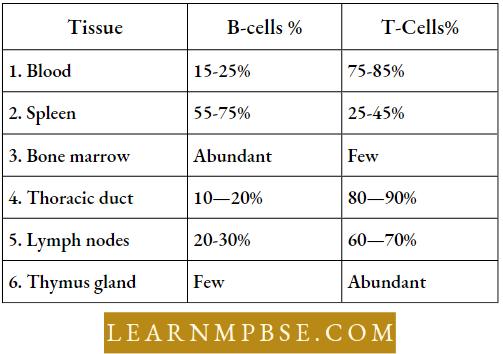
Antibody Action (Effector Mechanism),
- Neutralisation. Some antibodies function as antitoxins and neutralise the toxins produced by pathogens/foreign chemicals.
- Agglutination. Antibodies called Agglutinins cause immobilisation and clumping of antigens (precipitation) and antigen-containing pathogens.
- Opsonisation/Adherence. Antibodies called opsonins (for example, IgG) attach themselves to the surface of antigen-containing cells so as to be recognised by phagocytes,
- Complement Mediated Cell Lysis. Antigen-containing cells are perforated by enzymes produced with the help of lysin antibodies (IgM IgG).
- Phagocytosis. The lysed immobilised clumped pathogens are engulfed by killer T-cells and other phagocytes.
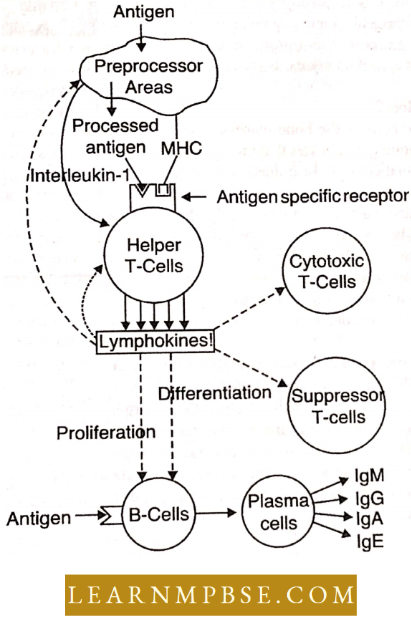
Principles Cells Of The Immune System
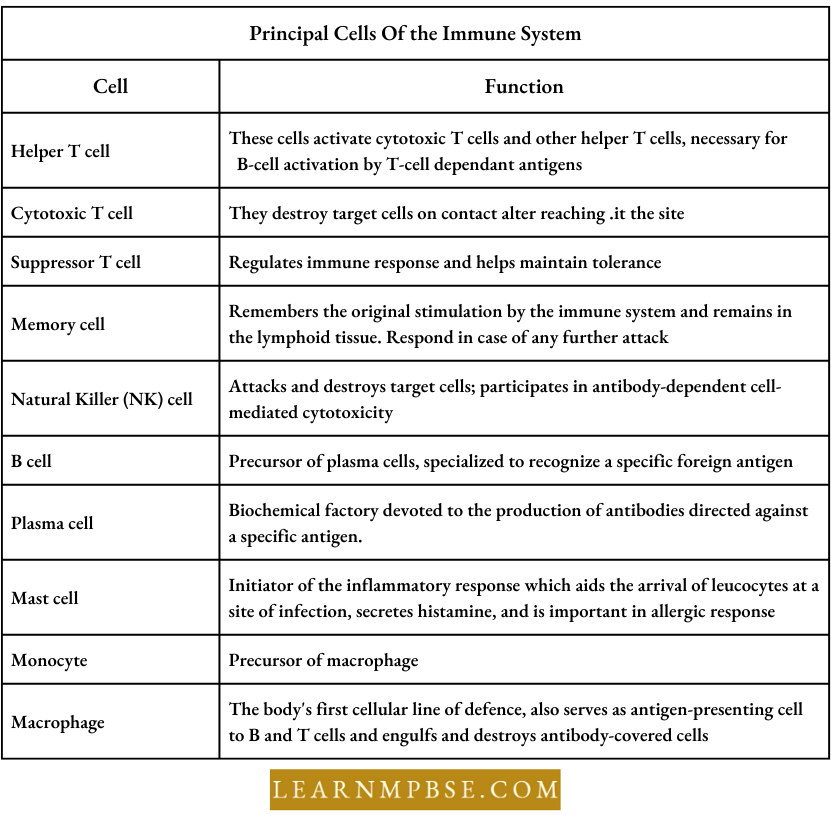
Immunity: After being stimulated B-cells and T-cells produce numerous effector cells and memory cells. Effector cells help in killing effective antigens and they live for a few days. The memory cells kill the antigens of the second infection and they live for much longer time and some may live even for the whole life.
These memory cells are stored in the spleen and lymph nodes. This explains the reason why some childhood diseases are not contracted for a second time. This is called acquired or active immunity. Immunity is of two types.
- Innate immunity—Inborn.
- Acquired immunity—Acquired after birth.
- Active acquired immunity
- Passive acquired immunity
Role Of Lymphoid Organs: The organs where lymphocytes are formed and mature, termed lymphoid organs. They are of two types i.e. Primary lymphoid organs and secondary lymphoid organs. Primary lymphoid organs such as hone marrow and thymus are the sites where B and T-cells can be produced.
- Secondary lymphoid organs such as lymph nodes, spleen, and mucosa-associated lymphoid tissue such as tonsils are the sites where lymphocytes are stored. They multiply and undergo differentiation at these sites.
- They acquire an immune response to antigens develop in their organs.
Human Health And Diseases Notes For Neet
Innate Or Inborn or- Non-specific or Natural Immunity:
It is present from birth and is inherited from the mother to offspring through the placenta. It is not acquired from the previous attack of disease, for example, innate immunity against distemper (a fatal disease of dogs) and cholera. It is the first line of defence. It consists of four types of barriers
- Anatomical
- Physiological
- Phagocytic and
- Inflammatory barriers.
Besides that phagocytes kill bacterial cells, virus-infected cells and some foreign cells of the body by creating perforin-lined pores in the plasma membrane of target cells. These pores allow entry of water into the target cell which then swells and bursts.
Acquired Immunity. The immunity acquired during a lifetime is called acquired immunity. It is specific and also known as adaptive immunity.lt requires many days to be activated. It has four unique properties
- Specificity
- Diversity
- Memory and
- Discrimination between self and non-self.
Specific Immunity employs two major groups of cells
- Lymphocytes and
- The antigen-presenting cells.
Properties Of Acquired Immunity
- Specificity. It is able to recognize various foreign molecules.
- Diversity. It can recognize a vast variety of foreign (non-self) molecules.
- Memory. The immune system responds to first encountered by forming antibodies. It retains the memory and if there is a second attack by the same antigen, (microbe/foreign molecules) evokes a heightened immune response.
- Distinguish Between Self And Non-Self Molecules. It can recognise and respond to molecules that are foreign or non-self
Activation Of Adaptive Immunity:
Every antigen is scanned by antigen-presenting cells like macrophages, B lymphocytes, etc. The processed antigen is present on the surface of these cells. A subgroup of T- T-cells, called T helper cells, specifically interacts with the present antigen and becomes activated.
The activated T helper cells then activate B cells and a subgroup of T cells called T cytotoxic cells in a specific manner. The activated B and T cytotoxic cells divide repeatedly to produce clones (similar cells). All the cells of a clone recognize the same antigen and fight it, neutralize the action or eliminate it.
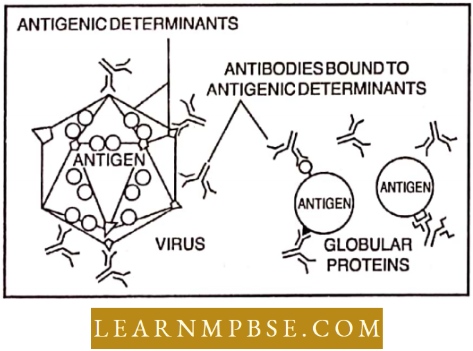
Vaccination: Originally the term vaccination (alter the Latin word vacca = cow) is described as the process of inoculating persons with discharge from cowpox to protect them from smallpox.
But now it is applied to the inoculation of any antigenic material for the purpose of producing active artificial immunity. The first successful polio vaccine (the Salk vaccine) was composed of viruses that had been inactivated by treatment will) formaldehyde.
Kinds Of Vaccine
- Killed Vaccine.
- The organisms are killed by phenol, alcohol, heat and UV rays, for example, Typhoid.
- Vaccine is prepared by killing organisms with the use of formalin, for example, whooping cough, and poliomyelitis (discovered by Salk).
- Toxoid. They have lost their toxic property but retained antigenic properties, for example, antitetanus, and diphtheria toxoids.
- Attenuated Living Vaccine. Oral ‘Live’ Sabine vaccine (OPV), Antipoliomyelitis (Salk); Antimeasles, B.C.G., yellow fever.
- Antigens Isolated From Infectious Agents, for example, polysaccharides of pneumococci.
- Antiserum/Serum. It is fibrinogen-free serum or blood plasma of an animal which has antibodies or antitoxins against a particular pathogen/toxin because the animal has been injected with a safe dose of the pathogen at regular intervals, for example, diphtheria, tetanus, or snake bite.
- Monoclonal Antibodies (Magic Bullets). They are identical antibody molecules, specific for a particular antigen, which have developed from a single source like hybridoma.
They were devised by Cesar Milstein and George Kohler (1975). Hybrid cell culture formed of antigen-sensitised cells, fused with myeloma/cancerous bone marrow cells for indefinite production of monoclonal antibodies.
Passive Immunity: Passive immunity is short-lived. Passive immunity occurs when an individual is given prepared antibodies and immunoglobulins to combat a disease. Since these antibodies are not produced by the individual’s B cells, passive immunity is short-lived.
- For example, newborn infants are passively immune to diseases because antibodies have crossed the placenta from the mother’s blood.
- These antibodies soon disappear, however, so that within a few months, infants become more susceptible to infections. Breastfeeding prolongs the natural passive immunity an infant receives from the mother because antibodies are present in the mother’s milk.
- Even though passive immunity does not last, it sometimes is used to prevent illness in a patient who has been unexpectedly exposed to an infectious disease.
- Usually, the patient receives a gamma globulin injection (serum that contains antibodies), perhaps taken from individuals who have recovered from the illness.
- In the past, horses were immunized, and serum was taken from them to provide the needed antibodies against such diseases as diphtheria, botulism and tetanus.
Interferon: Interferon was first identified in 1957. These are proteins released by cells in response to a viral infection which they help to combat. They do not inactivate the virus but make the healthy cells less susceptible to the viral attack and prevent the viruses from taking over the machinery of the cells. Interferons have proved to be effective in treating influenza and hepatitis.
Common Human Diseases Neet Notes Pdf
Antisera
- Prior to the development of vaccinations, serum with preformed antibodies was utilized.
- This serum is referred to as Antiserum or hyperimmune serum.
- When utilized for protection, it is referred to as prophylactic serum.
- When utilized for therapeutic purposes, it is referred to as therapeutic serum, generally known as Gammaglobulin.
- It is derived from human blood sera provided by donors and contains antibodies.
- In certain instances, the body identifies these serum antibodies and antigens, subsequently generating antibodies against them in an allergic response. This condition is referred to as serum sickness.
- It leads to rash, respiratory distress, and joint swelling.
Human Health And Common Human Diseases For NEET Autoimmunity
The immunity developed against one’s own structure is known as autoimmunity. It has been observed that sometimes the immune system of the body goes off track and starts working against the own body and this in turn leads towards disease for example immunity developed against RBCs causes Anaemia and autoimmunity against the muscular system causes severe wsafeness (myasthenia gravis).
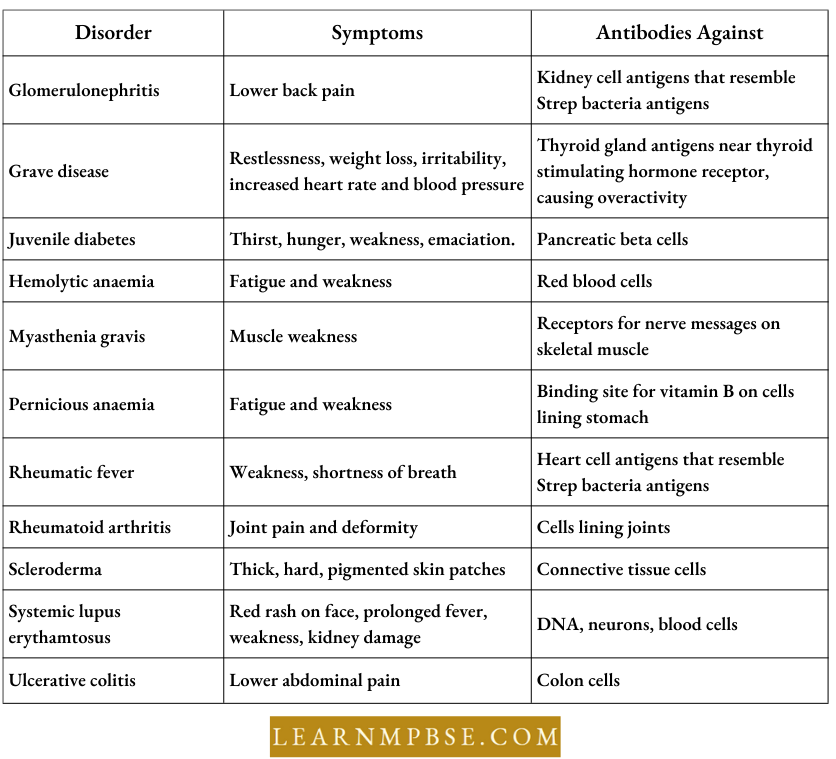
Human Health And Common Human Diseases For NEET Immunodeficiency
It is a disorder of the immune system where one or both components are unable to work properly due to congenital or acquired disease.
- SCID (Severe Combined Immunodeficiency): It is a congenital immunodeficiency disorder in which both B—and T—lymphocytes are not formed and the patient dies of even minor infection (Such children can survive only in germ-free isolation chambers).
- Acquired Immuno-Deficiencv Syndrome (AIDS) Cause. AIDS is a severe viral disease which has been able to overcome all the defensive mechanisms of the human body and generally leads to death.
It is caused by a retrovirus-HIV (Human immunodeficiency virus), earlier called LAV (Lymphadenopathy-associated virus) or HTLV (Human T-lymphotropic virus). It was first reported in African green monkeys but was first isolated in man by Moulagnier et al. (1983) and Gallo et.al. (1984). Its genetic material is RNA so it multiplies through the process of reverse transcription. Another peculiar feature of HIV is its mutability.
HIV– Human Immunodeficiency Virus
Subgroup- Lentivirus
Family– Retroviridae
Incubation Period, It ranges between 15-57 months. The average incubation period is 8 months.
Sites From Which HIV Can Be Isolated.
- Blood
- Semen
- Cervical fluid
- Saliva
- Breastmilk
- CSF
- Tears
- Skin
- Lungs
- Glial cells, Microglia of CNS.
AIDS Is a Pandemic Disease Symptoms. HIV attacks Helper T- lymphocytes. The reduction in number of Helper T-lymphocytes causes severe cellular immunodeficiency. The number of T-cells drops to even below 200 in comparison to 500-1500 in a normal person.
So it is a disorder of the cell-mediated immune system of the body. These clinically unhealthy persons are called opportunistic. AIDS is characterized by one of the following symptoms:
- Pneumocystis Carinii Pneumonia (PCP) is a lung disease. Idiopathic multiple-a skin cancer (Kaposi’s sarcoma) These forms 70% of AIDS cases.
- Psychosis Or Chronic Encephalitis– severe brain damage.
- Thrombocytopenic Purpura– decreased count of blood platelets causing haemorrhage.
- Lymphoma – cancer of lymphatics.
- Lymphadenopathy- swelling of lymph nodes.
- Another peculiar symptom of AIDS is severe wasting syndrome (substantial weight loss and general decline in health).
- AIDS patients also become more susceptible to infections of any system of the body.
- When the brain is damaged, then it may cause loss of memory, and the ability to speak and even think.
A full-blown AIDS patient dies within three years and mortality is 100%. The most serious form of AIDS is AIDS-related complex ARC which is characterized by swollen lymph nodes, night sweats and loss of weight.
New Anti-Retrovirus Drugs Against HIV
- Protease Inhibitors in combination with AZT blocks the enzyme essential for multiplication of HIV-virus.
- Sustiva, also called Efavienz, was developed by Food and Drug Administration (FDA) of USA in September, 1998.
- XQ- 9302, a Chinese herbal medicine.
- Interleukins (a class of proteins secreted by immune cells) when given in combination with AZT and protease inhibitors can remove the virus even from CD- 4 cells where the virus hides and rests.
- Nono Xynol- 9, a spermicide in gel form and claimed to be anti- HIV is found to be ineffective in protecting women from HIV- Infection.
- Nevirapine pervents HIV transmission from mother to child.
Two Serological Tests For Anti-HTV Antibodies
- Screening Test.
- Confirmatory Test.
- Screening Test. These tests are not highly specific. The most widely used screening test is the ELISA test.
- Confirmatory Test. A commonly employed confirmatory test is the Western Blot test. It is carried out after the screening test shows a positive result.
Immunosuppressants: They are chemicals which suppress the immune reaction of the body towards transplanted organs (for example, kidney, parts of the intestine, heart) for example, cyclosporin.
Infectious Diseases—some of them fatal, have newly emerged and were not previously known:
- HIV infection which causes AIDS
- Hepatitis C, B and E
- A new form of Cholera
- A highly fatal respiratory disease caused by a virus called Sin Nombre
- A variant of Creutzfedt-Jakob disease—a disease of the central nervous system
- Ebola haemorrhagic fever
- A haemolytic uraemia syndrome
Reemerging Infectious Diseases: Some of the infectious diseases which were earlier controlled are now reappearing in epidemic forms. They are
- Tuberculosis
- Cholera
- Dengue
- Malaria
- Plague
- Meningococcal meningitis
- Diphtheria
- Japanese encephalitis
Diseases Caused By Bacteria
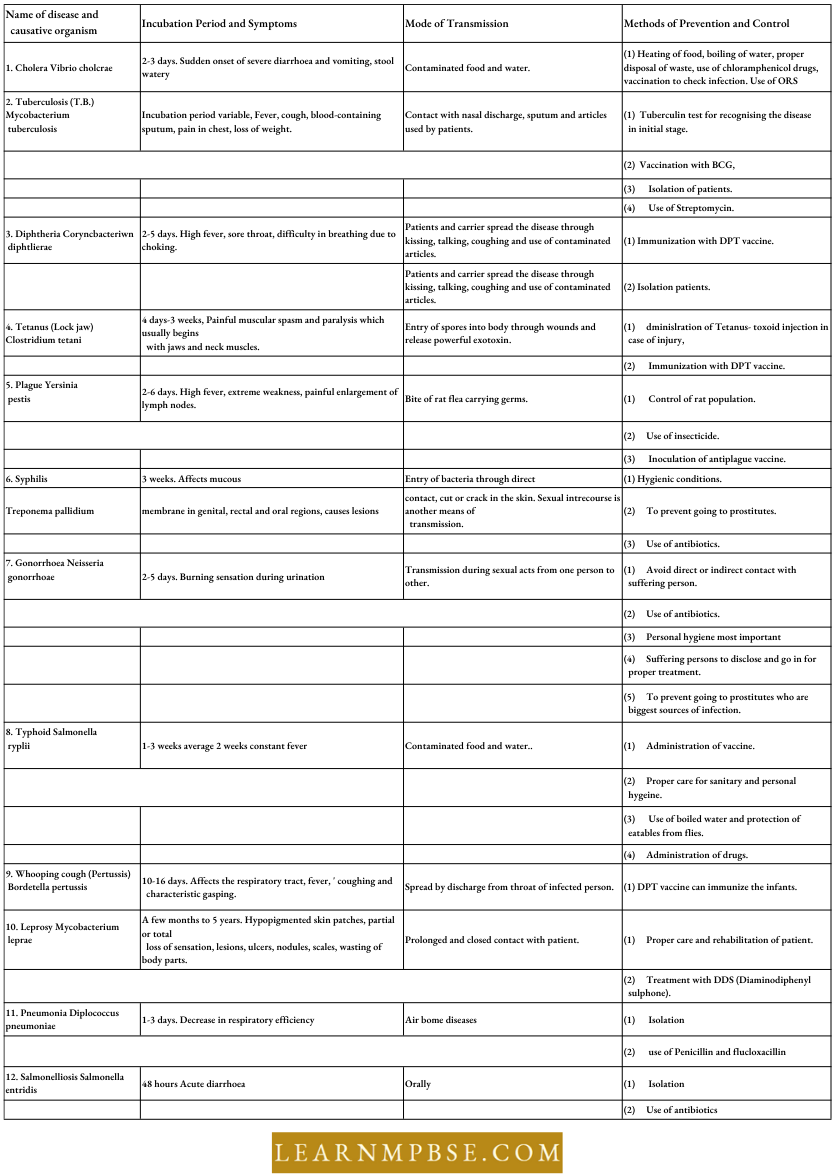
Other Bacterial Diseases Are diarrhoeal diseases (Shigella, Escherichia coli, Campylobacter, Salmonella etc.), botulism (food poisoning – Clostridium botulinum); anthrax (Bacillus anthracis); meningitis (Neisseria meningitis) etc.
Human Diseases And Their Causes Neet Biology
Diseases Caused By Viruses
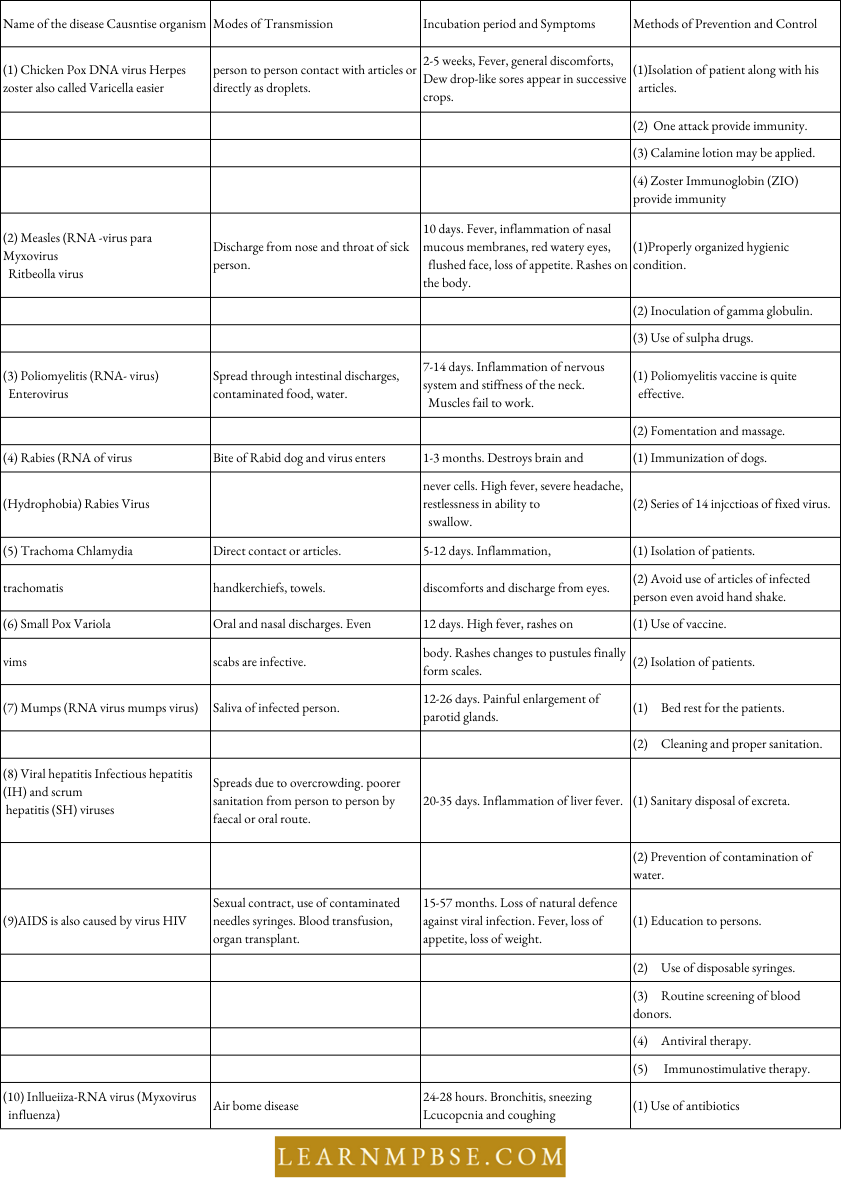
Dengue Fever. It is a viral fever whose vector is a daytime-biting Aetles aepypti mosquito. Its incubation period is of seven days.
- It is characterized by high fever (above 102° F), severe frontal headache, pain behind the eyes, muscular and joint pain, loss of appetite, measles-like rash on the chest and upper limbs, nausea, vomiting etc.
- Dengue haemorrhagic fever is also associated with bleeding from the nose, mouth, and gums and vomiting. In October 1996, Dengue fever was declared as an epidemic.
- Adult Aetles mosquitoes can be killed by spraying malathion. Aedes mosquito has small, black and white strips on its legs and back. It bites during the daytime in the early hours of the morning and late hours of the afternoon.
The hepatitis -B Virus causes so many deaths in only one day as by AIDS virus in one year. In India, about 4.30 crore people suffer from hepatitis- B. The vaccine against hepa- titis-B is available and is given to the 6th, 10th and 14th years age group of children.
Revac-B vaccine is a genetically engineered vaccine against hepatitis-B disease. It has been developed by Bharat Biotech International Ltd. (Hyderabad).
SARS (Severe Agile Respiratory Syndrome): Typical pneumonia is an infection of lung tissue caused by organisms other than pneu¬monia causing organisms, maybe a virus, metapneumo virus another virus called corona vims has also been identified.
- Symptoms And Signs Of SARS
- High fever
- One or more respiratory symptoms (Cough, breathlessness or hypoxia.)
- Headache, muscular stiffness, loss of appetite vague feeling of discomfort, confusion, rash and diarrhoea
- Close contact with a person having SARS for the previous 10 days.
- Countries Which reported SARS cases: China. Hongkong, Taiwan province, Singapur, Vietnam and Canada In India only 12 cases of SARS were reported.
- Modes Of Transmission Droplet infection spread through respiratory surface Diagnostic Test. Rapid molecular Genetic Test ( PCR Test) 2. Serological Test. Treatment. Combination of Antiviral drugs and cortical steroids plus other intensive supportive treatment.
Protozoanal Diseases: Malaria, amoebiasis, sleeping sickness etc are the main protozoan diseases caused by Plasmodium, Entamoeba and Trypanosoma respectively. Malaria is spread by the female Anopheles mosquitoes, amoebiasis is spread by contaminated food and water, and sleeping sickness is spread by Glossina (Tse-tse fly).
Helminth Diseases: Tueniasis, ascariasis and filariasis are common helminth diseases of man. These are caused by Taenia solium, Ascaris lumbricoides and Wuchereria bancrofii respectively. Human infection of Taenia occurs by taking undercooked measly pork while that of Ascaris occurs through contaminated food. Filariasis is spread through Culcx and Aedes mosquitoes.
Important STDs And Common Techniques For Their Detection
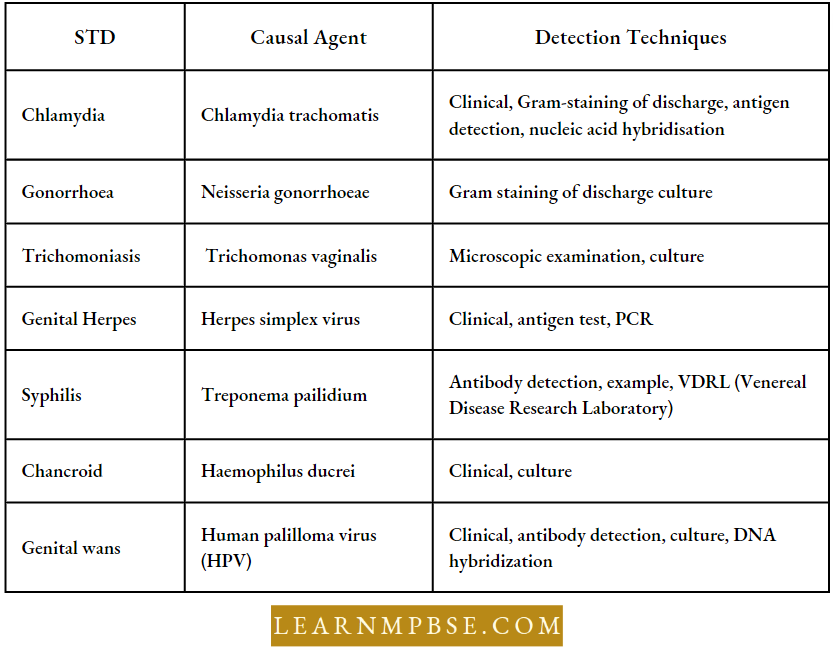
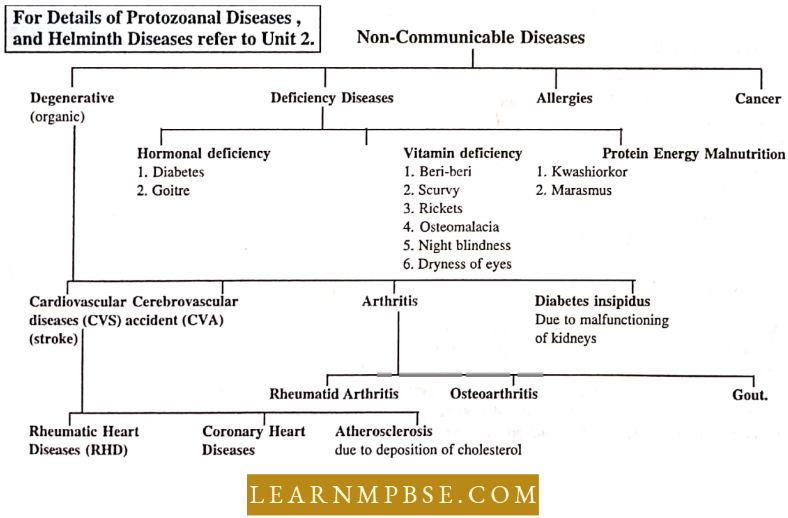
Heart Diseases: These are the most common cause of death in human beings in the present century. Rheumatic heart diseases result from the repeated attacks of rheumatic fever in childhood.
- The toxins cause inefficiency of the valves between the auricle and the anti-ventricle. Arteriosclerosis is another common cardiovascular disease caused by the deposition of calcium or cholesterol in the walls of the arteries. Hypertension is characterized by persistent high blood pressure.
- Coronary thrombosis, also called myocardial infarction, involves the formation of a thrombus in the coronary artery. High sperm cholesterol, cigarette smoking, hypertension, diabetes and obesity are other risk factors for coronary heart disease.
Diabetes Mellitus
Diabetes Mellitus Causes
- Deficiency of insulin hormone due to hypoactivity of p—p-cells of Islets of Langerhans of the pancreas.
- Obesity and overweightness.
- Mental shocks.
- Heredity (diabetes controlled by a recessive gene present on the short arm of chromosome 11).
Diabetes Mellitus Symptoms. Due to a deficiency of insulin hormone, the person can neither store glucose as glycogen nor use glucose as respiratory fuel, so diabetes mellitus is characterized by:
Human Health And Diseases Neet Previous Year Questions With Answers
Hyperglycemia (blood glucose many times greater than normal), polyuria or diuresis (excessive urination, about 10 litres per day), polydipsia (excessive thirst), polyphagia (increased hunger), glycosuria (sugar in urine, about 100 g/24 hrs), loss of weight, decreased glycogen level in liver, blurred vision, reduced healing capacity etc. Due to incomplete oxidation of fats, ketonic bodies are formed, so secondary symptoms of diabetes mellitus are:
Ketonemia (ketones in the blood), Ketonuria (ketones in urine), acidosis (pH of blood decreased from 7.4 to 6.8), diabetic coma and death.
- A person suffering from diabetes is called a diabetic. It is reported in about 1-3% of Indian population. China now has 20 million diabetics and their number is swelling each year by 750,000. About 5.3 per cent of the inhabitants of Beijing city suffer from diabetes.
- So Beijing is becoming the city of diabetics. There are over 15 million known diabetics in India with Delhi alone accounting for over 3 lakhs. Increasing urbanization and a changing lifestyle with less physical exercise and overeating are responsible for the increase.
27th June is called Diabetes Day: Diabetes occurs in two forms
- Insulin-dependant Diabetes (IDDM—Type-1 diabetes). It occurs due to a deficiency of insulin from (β cells of Islets of Langerhans. It is more severe and generally occurs in young.
- Non-insulin-Dependent Diabetes (NIDDM—Type-2). It occurs due to the failure of the target cells to take up insulin from the blood. It generally affects after 40 years of age. Patients are mostly overweight so should reduce their weight by a low-calorie diet and exercise.
Diagnosis. Diabetes mellitus can be diagnosed by testing blood and urine sugar levels.
Diabetes Insipidus
Diabetes Insipidus Cause. The main cause of diabetes insipidus is decreased secretion of ADH (anti-diuretic hormone), also called vasopressin, from the neurosecretory cells of the hypothalamus and released from the posterior lobe of the pituitary gland.
Diabetes Insipidus Symptoms. Deficiency of ADH causes decreased permeability of the wall of collecting tubules and decreased reabsorption of water from the urine, so diabetes insipidus is characterized by:
Diuresis, polydipsia, loss of weight, weakness etc. but urine is sugar free.
Arthritis: It is a disease more of advanced age characterised by the abnormality of joints. The common three types of arthritis are :
- Degenerative Arthritis (Osteoarthritis). It first attacks the cartilage of the joint. The lumps are formed which make the movement impossible. It causes joint fixation or ankylosis.
- Rheumatoid Arthritis. It first attacks the synovial membrane (membrane which lines the joints) and causes inflammation which leads to stiffness of the joints.
- Gout. It is a type of arthritis in which the accumulation of uric acid crystals occurs at the joints. These crystals make movement difficult and also cause severe pain.
Human Health And Common Human Diseases For NEET Allergies
Allergies Definition. An allergy is the hypersensitivity of a person to some foreign substance, called an allergen, which either comes in contact with or enters the body. About 15% of the Indian population suffers from one or other type of allergic disorder.
- Allergy, also known as hypersensitivity, is an inappropriate overreaction of the immune system.
- An allergy is a non-infectious, unnatural and unusual reaction to a substance called an allergen which is generally a weak antigen.
- Common allergies are anaphylaxis, urticaria, hay fever, asthma, eczema, etc.
- Antibodies belonging to the class IgE trigger allergy by combining with the antigen and surface of mast cells in the connective tissue.
- Mast cells release a large amount of histamine into the bloodstream.
- The symptoms of an allergy reaction develop in response to histamine which stimulates capillary dilation, increased permeability, closure of bronchial tubes, mucus secretion, pain and swelling.
- A severe allergic reaction called anaphylactic shock occurs when a large amount of histamine is suddenly) released by the mast cells.
- All the peripheral arteries dilate at once causing a very low blood pressure or shock. It is fatal if not immediately treated.
- Allergies are treated with drugs that cause vasoconstriction: antihistamines in the case of normal allergic reaction and epinephrine in the case of anaphylactic shock.
Human Health And Common Human Diseases For NEET Inflammation
Inflammation Definition. Damage to the body’s tissues triggers a defensive response called inflammation.
- Inflammation can be caused by microbial infection, or physical agents (heat, radiant energy, electricity or sharp objects).
- Inflammation is usually characterized by four symptoms.
- Redness
- Swelling.
- Heat
- Pain
- Sometimes a fifth symptom, loss of function, is present,
- Inflammation has the following functions:
- To destroy the injurious agent to limit the effects of the injurious agent on the body by confining or walling off
- To repair or replace tissue damaged by the injurious agent
- Any substance or agent that tends to cause a rise in the body temperature (fever) is called pyrogen.
- Pyrogens are released by WBCs that set the body’s thermostat at high temperatures.
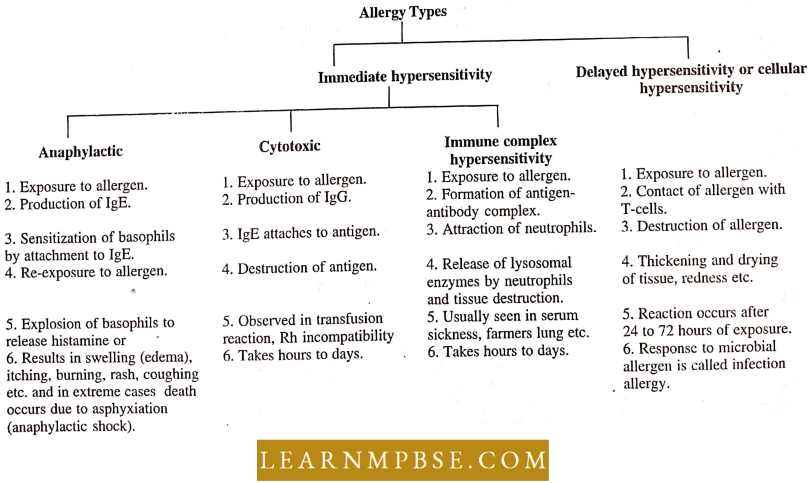
Type Of Allergens. The common allergens are dust, pollens, spores, feathers, fur, venom food and drugs. Some physical agents also act as allergens.
Allergens Mechanism. It involves 3 steps:
- Sensitisation. In this, allergen acts as a mild antigen so stimulates the formation of antibodies which bind to mast cells of connective fissure.
- Second Stimulation. In this, allergens combine with antibody-bound mast cells which rupture and release histamine.
- Histamine Action causes hypersensation.
Human Health And Diseases Neet Previous Year Questions With Answers
Symptoms Of Allergic Reactions. The following are the symptoms of allergies
- A person may suffer from high fever which affects the mucous membrane of the eyes, nose and upper respiratory tracts.
- The mucous membrane of the lower part of the respiratory tract leads to cough and asthma.
- Reddening of skin, the appearance of blisters on the skin.
- Accumulation of tissue fluid below the skin.
- Watering of eyes and inability to breathe.
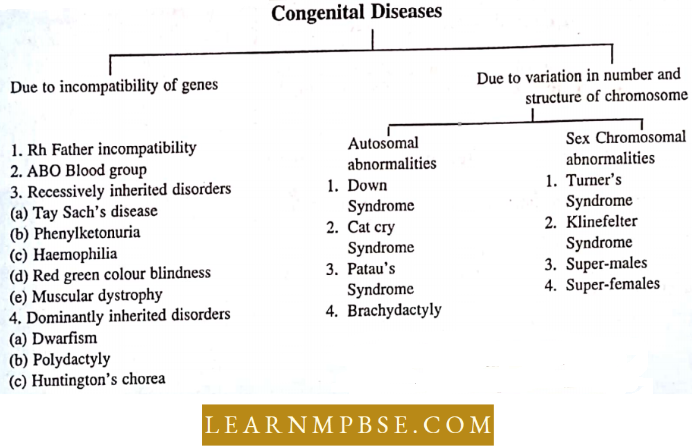
Human Health And Common Human Diseases For NEET Cancer
Cancer is characterized by uncontrolled growth and division of certain body tissues, so forming a tumour. It is more common in people between 40 to 60 years of age. It is one of the chief killers today. Every year about 6 million people throughout the world are diagnosed as having cancer, being equally divided between developed and developing countries.
- In the world, about 4 million people die of cancer which accounts for about 10% of all deaths. In India, 80 per cent of cancer patients come from viral areas and are first diagnosed with cancer at an advanced stage.
- Neoplasm is a new abnormal tissue that is capable of continued growth, formation of tumours, crowding and disruption of normal cells. Tumours are of two types, benign and malignant. A benign tumour is a large localised mass of abnormal tissue which presses other tissues but does not infiltrate adjacent tissues because it is encapsulated in connective tissue.
- A Malignant Tumour is a large mass of abnormal tissue which is not encapsulated, is capable of invading adjacent tissue and distant sites. Metastasis is the spread of cancerous cells from one part of the body to other parts through blood, lymph or the formation of secondaries from a malignant tumour.
Cancers Are Of the Following Types:
1. Carcinoma:
It is a carcinoma of epithelial or epidermal tissues and its derivatives, including skin, mucous membranes, glands, lungs, breasts, pancreas, and stomach.
2. Sarcoma:
It is a malignancy of primordial mesodermal tissue, including connective tissue, bone, muscle, and lymph nodes.
3. Kaposi:
Kaposi sarcoma is a secondary condition linked to AIDS. Leukemia (= Leukemia). It is a malignancy characterized by an excessive and uncontrolled proliferation of white blood cells (200,000—1,000,000/mm³) and immature myeloid stem cells.
In a prevalent form of leukaemia, white blood cells invade the bone marrow, spleen, liver, lymph nodes, and other organs, resulting in damage and enlargement.
In myelocytic leukaemia, the 9th and 22nd chromosomes amalgamate their transposable elements, resulting in the degeneration of erythroblastic tissue in the bone marrow.
Hemorrhaging is occurring at several locations. Tonsils and cervical lymph nodes hypertrophy. The predominant cancers in India are oral-pharyngeal cancer in males and cervical-uterine cancer in females.
4. Adenoma: Glandular carcinoma
5. Lymphoma:
It is a malignancy of the lymphatic system and spleen, characterized by the overproduction of lymphocytes.
Carcinogenic Factors (Factors inducing Cancer).
Carcinogens/Chemical Carcinogens. They are substances/often environmental pollutants which cause cancer, for example, soot (skin, lungs). coal tar (3, 4, benzopyrene—skin and lungs), cigarette smoke (N-nitroso- dimethyl—lungs), cadmium oxide (prostate gland), aflatoxin (liver), 2-naphthyl amine and 4-aminobiphenyI (urinary bladder), mustard gas (lungs), nickel and chromium compounds (lungs), asbestos (lungs, pleural membrane), diethylstilbestrol (DES—vagina), vinyl chloride (liver).
- Radiations. Both UV and ionising radiation increase the incidence of cancer. For example, Leukaemia incidence is 10 times higher in radiologists than other medical workers.
- Heat. Reverse smoking causes mouth cancer. Kangri (heating device) increases the incidence of cancer in Kashmiris.
- Tobacco. Tobacco chewing produces mouth cancer. Smoking increases the chances of throat and lung cancers.
Biological Agents. Some viruses and other parasites, excessive secretion of certain hormones are believed to produce cancers.
Mechanical Agents. Friction, trauma or continuous irritation seem to produce cancer.
Mechanical Agents Symptoms. A lump or hard area, swelling or sore that does not heal, unexplained loss of weight, difficulty in swallowing, persistent cough or hoarseness, change in colour of a mole/wart, a change in digestive/bowel habits, loss of blood through a natural orifice or excess out of date loss of blood in women.
Therapy: Cancer can be controlled in early stages and control depends upon the location and spread of the cancer
1. Radiation Therapy. In this, the cancerous parts of the body are exposed to ionising radiation like X-rays which kill the cancerous cells. It gives good results in skin, lip, mouth and cervix cancers.
It is used in almost 80% of cancer patients for treatment Brachytherapy is a special radiotherapeutic technique in which a very high doze of radiation in a short period to a small volume of body tissue by small radioactive sources like Radium, Cobalt 60, Iridium-192, etc. arranged in a geometrical fashion in and around the tumour.
2. Hormonal Therapy. In this, a hormone-caused cancer is treated by another hormone which neutralizes carcinogenic hormones for example, breast cancer can be controlled by testosterone.
3. Surgery. It involves the removal of cancerous parts by operative methods.
4. Chemotherapy. A number of chemicals like mercaptopurine, 6-aminopterin etc. are known to kill cancerous cells or inhibit DNA synthesis and cell division in cancer cells. Catharantlius roseus, commonly called sadabahar, provides two anti-cancerous drugs; Vincristin and Vinblastin which are used against leukaemia.
A new drug called Photoferin has been discovered in the U.S.A. to cure throat cancer. It is a modified porfimer sodium extracted from cow’s blood.
Drugs Used In Chemotherapy Of Cancer
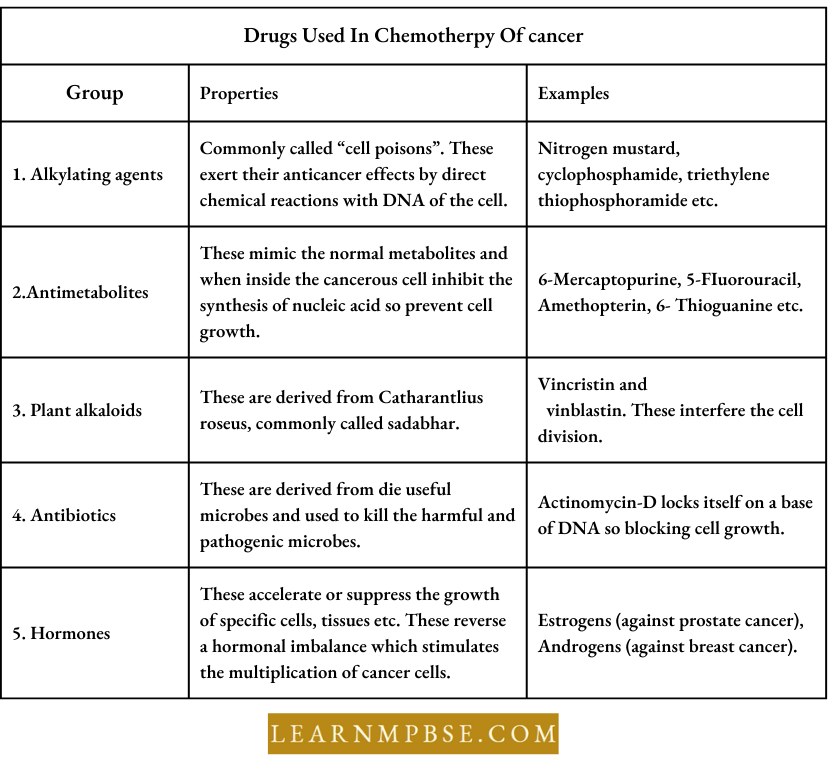
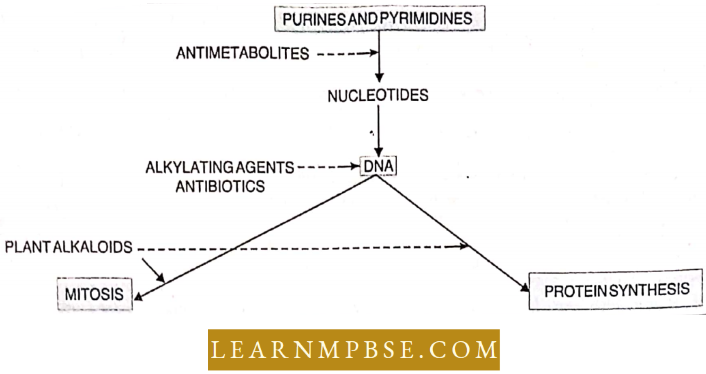
5. New Anti-Cancer Drugs. The new drug, Doxil, contains an antitumour ingredient called Doxorubicin.
- Recently Israeli researchers have developed a new technique of new dmg delivery in which liposomes (a group of ball-like biomaterials) infiltrate the malignant tumours through the gaps in the blood vessels of cancerous tissue and release the anticancerous doxil to kill the cancerous cells.
- These liposomes cannot penetrate into healthy tissue as no such gaps exist in their blood vessels.
6. Gene Therapy For Skin Cancer. A revolutionary form of gene therapy for skin cancer has been developed by Mary Collins of the Institute of Cancer Research (London). In this, tumour cells are genetically engineered to carry a protein—Interleukin-2.
Then the tumour cells are injected into the skin of the patient where they begin to release Interleukin- 2 which stimulates the white blood cells to attack cancer cells in the skin, hopefully preventing cancer from spreading.
Therapy Mechanism: Carcinogenic factors activate certain genes called oncogenes. Jumping genes or transposons are also involved. The activated oncogenes result in uncontrolled cell proliferation or cancer.
Cancer cells have irregular, hypertrophied nuclei, abundant nuclear granules, an increased number of lysosomes, reduced cristae in mitochondria, melanin, mucus, fat droplets and debris in cells.
ABO Blood Group:
Whether a person has type A, type B, type AB or type O blood depends on the presence or absence of specific substances on the red blood cells. There are two of these substances- antigens A and B.
- Thus a person with antigen A is considered to be with blood group A, a person who is in blood group O has neither of the antigens and a person with antigen B, blood group is called B. If both the antigens A and B are present the blood group is called AB. The blood group character is controlled by a set of three alleles.
- During injury or disease blood is lost and is generally replaced by transfusion. The blood is obtained from a donor and must be compatible with that of the person receiving, i. e.. recipient.
- In case the blood is not compatible then the antibodies present in them cause clumping of blood in the capillaries and may result in death. The plasma of B-group blood contains antibodies A. The formation of clumps occurs in case B group blood is mixed with blood group A.
Human Health And Diseases Neet Previous Year Questions With Answers
Rh Factor. The Rh-blood types were first discovered in the Rhesus monkey. It was found that RH (rhesus) antigens were causing many of the transfusion failures that were unexplained by the A-B-O system. There are at least eight different Rh antigens discovered so far. A person is called Rh- Rh-Rh-positive if he has any one of these antigens and Rh-negative if the antigens are absent.
- A complication arises if the blood of an Rh-negative is transferred to Rh- a positive individual or vice-versa.
- When the red blood cells of an Rh-positive person is transfused into a person with Rh-negative blood an agglutination of red cells occurs. The antibodies against the Rh antigen are present in the Rh- Rh-negative person. The agglutinated cells clog up capillaries and the white cells of the recipient attack and break up the red blood cells (hemolysis).
- Repeated exposure to transfusion increases the speed and seriousness of the antibody-antigens response. In such cases, serious complications arise which lead to death.
